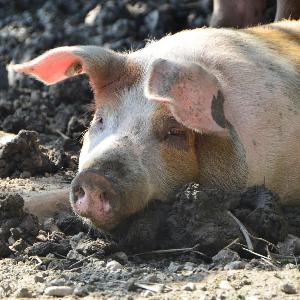Paleogenomics: Tracing tangled threads through time
8 Dec 2021
When and where did wolves become dogs? LMU geneticist Laurent Frantz uses modern genome sequencing methods to trace the process of animal domestication.
8 Dec 2021
When and where did wolves become dogs? LMU geneticist Laurent Frantz uses modern genome sequencing methods to trace the process of animal domestication.
They have names like “Grey Wind” and “Ghost”, and for fans of Game of Thrones they are “majestic, loyal and obedient”. The tale of the huge and heraldic “shadow wolves” is, in essence, the story of a domestication process. However, Canis dirus (“the fearsome hound”), the species that inspired this strand of the fantasy saga, is unlikely to have exhibited the attributes cited above, and was probably a poor candidate for domestication. Once found all over North America, C. dirus died out about 13,000 years ago. Until very recently, it was thought to have been closely related to the wolf. Indeed, apart from being larger and having much more robust jaws, C. dirus looked very like the wolf. But based on extensive genetic studies, Laurent Frantz and colleagues have shown that the two belonged to different lineages.
So what does the wolf’s family tree really look like? When and where were wolves domesticated? Professor Frantz is a specialist in the paleogenomics of domestication. He analyzes ancient DNA, which can be isolated from the skeletal remains of animals excavated by archaeologists, and compares it with the genomic DNAs of living animals. In this way, it is possible to trace the ancestral relationships between species and reconstruct evolutionary processes – such as the emergence and extinction of species and lineages, and anthropogenic selection, which is the basis for domestication – through time. Frantz is interested in that process in dogs, pigs, poultry, cats, cattle and sheep.
Frantz is a member of the large-scale international collaboration that has now sequenced DNA from five representatives of C. dirus, dating back to more than 50,000 years ago. The results show that, despite their morphological resemblances, modern wolves are – at best – distant cousins of the ‘dreadful wolf’. In fact, C. dirus was the last member of a now extinct lineage which diverged from the ancestors of modern wolves almost 6 million years ago, and later followed its own, independent evolutionary trajectory. “The genetic differences are so substantial that Canis dirus very probably could not have interbred successfully with other canids, such as coyotes or wolves,” Frantz explains. “To explain the extent of the differences, one must assume that the species was genetically isolated in North America for a very long time.”
Wolves, however, were widely distributed in Eurasia during the late Pleistocene. So which lineage gave rise to the progenitors of our domesticated dogs? It is now clear that dogs were domesticated long before humans established long-term settlements in the Near East, and began to keep sheep and goats. Dogs have followed their owners for at least the last 15,000 years. “That’s one reason why it’s so difficult to pin down the place of origin of domesticated dogs,” says Frantz. “Humans didn’t live in permanent settlements at that time, so left few traces in the archaeological record.” Frantz works closely with archaeologists, paleontologists and historians. They provide the chronological, socio-economic and ecological context for sites that yield ancient DNA, and enable a detailed picture to be constructed.
The extreme cold, the dry air and the isolation could have promoted close contact with wolves.Laurent Frantz
According to Frantz, the evidence now strongly suggests that wolves were first domesticated about 23,000 years ago in Siberia. It comes from 71 ancient DNA samples from dogs found at archaeological sites in North America, which he and his colleagues have sequenced. The data demonstrate that all of the dogs belonged to a now extinct lineage, which was not related to wolves found on the American continent. Instead, their DNA sequences are most closely related to those of fossil dogs discovered in Siberia.
“We assume that the first people to reach North America brought their dogs with them, when they journeyed to the New World over 20,000 years ago,” says Frantz. This idea is supported by genetic analyses of ancient human DNAs from this period, found along the route that he and his colleagues had traced based on ancient canid DNAs. The findings imply that there were domesticated dogs in Siberia at the time of the last glacial maximum, between 23,000 and 19,000 years ago. Given the low population density there, the researchers regard it as highly unlikely that dogs could have been brought to Siberia from elsewhere. “Indeed, the extreme cold, the dry air and the isolation could have promoted close contact with wolves,” Frantz suggests.
In this scenario then, dogs accompanied their owners as they dispersed in all directions, and by about 11,000 years ago, the canids were already highly diverse. Based on the sequencing of ancient DNA isolated from 27 dogs from prehistoric contexts in Europe, the Near East and Siberia, an international research team including Frantz concluded that they belonged to five different lineages – providing further support for the notion that the domestication process must have begun long before that time. Analyses of DNA from 17 humans discovered in the same archaeological contexts revealed significant correlations between the two datasets, which suggests that dogs and humans were on the move together. The first farmers who migrated to Europe and Africa from the Levant also brought their dogs with them. Strikingly, however, while the people who migrated from the Eurasian steppes to Europe during the Bronze Age left clearly influenced the genetic make-up of present-day Europeans, their dogs made little impression on the genomes of the native canine population. Perhaps the local breeds were better adapted than incoming dogs to the prevailing conditions or less susceptible to endemic infectious diseases.
It’s like fishing. We have analyzed about 1500 dog bones in our lab, and were able to sequence only about 20 genomes.Laurent Frantz
Such extensive paleogenomic studies are the result of advances in molecular biological methods, including new techniques for the recovery of analyzable DNA from highly degraded samples. Research on ancient DNA resembles the proverbial search for the needle in the haystack. Chemically speaking, DNA molecules are not very stable, and undergo progressive degradation after death. Whether suitable bones are available depends on the site and is unpredictable. “When a mammoth died in the high Arctic, it was rapidly preserved by freezing, and DNA is much more stable in ice than it is in a tropical jungle,” says Frantz. “It’s like fishing. We have analyzed about 1500 dog bones in our lab, and were able to sequence only about 20 genomes.”
The advent of high-throughput procedures – collectively called ‘Next Generation Sequencing (NGS)’ – has revolutionized the analysis of DNA sequences over the past 10 years. Millions of DNA fragments can now be simultaneously sequenced at an affordable cost, and short breakdown products now yield readable information – an important advance, given that ancient DNA molecules are often highly fragmented.
But the new opportunities have also thrown up new challenges, as Frantz points out, primarily because of the enormous size of the datasets that can now be generated. Many of his colleagues, he says, have considered storing the samples instead of the sequence data, because resequencing is the more economical option. Apart from the problem of data storage, there is the question of algorithms: how can the data best be analyzed? “Munich offers a very good supercomputing infrastructure, and is therefore an attractive location for this sort of research,” says Frantz, who moved to LMU from London in September 2020.
“For me, one of the biggest surprise in the dog domestication story is the finding that, over the last 10,000 years, there has been virtually no gene flow from wolves into dogs,” says Frantz. “Following the initial domestication, there has been little or no mixing, although species closely related to dogs mate quite frequently.” He speculates that this might reflect strong selection on the part of humans against potentially more aggressive hybrid wolves.

© IMAGO / Christine Roth
These findings contrast sharply with what Frantz found in his studies on the domestication of pigs. Pigs arrived in Europe with the expansion of agriculture from the Fertile Crescent around 10,000 years ago. However, within a few hundred years, the newcomers had interbred with the local wild boars to such an extent that their own genome was no longer recognizable. Not only that cthe pig is the only species for which there is compelling evidence for two separate sites of domestication.
“The pig family is also of great interest from an evolutionary point of view,” says Frantz. “How can a domesticated pig retain its character, when the majority of its genome is more closely related to that of the wild boar?” The answer may lie in epigenetic modifications – chemical changes in the DNA that do not change its nucleotide sequence, but can have an effect on the regulation of gene activity. At the moment, Frantz is engaged on a study to determine whether wild boars reared in captivity differ epigenetically from their free-ranging congeners. In collaboration with colleagues, he plans to reconstruct the epigenomes of some other early animals too. “There are ways of mapping the epigenomes of DNA samples isolated from animal bones. Experimentally, it’s a challenging task, but I believe that it’s a very promising approach.”
The destruction of the habitat has been accompanied by an erosion of genetic variabilityLaurent Frantz

Prof. Dr. Laurent Frantz is Professor of the Paleogenomics of Domesticated Animals in the Faculty of Veterinary Medicine at LMU.
Ancient DNA not only reflects the genetic past of a species, it can also throw light on its future. On the Indonesian island of Sulawesi, Frantz is investigating the genetic make-up of two endangered – and endemic – species: the babirusa, which belongs to the pig family, and the anoa, a kind of miniature buffalo. Both species are under threat owing to the continuing degradation of the rainforests in which they live. The animals have fascinated zoologists since their discovery. Many ended up in museums, and some specimens date back to the 19th century.
This has enabled Frantz to compare their genomes to those of living representatives of the two species – and allowed him to assess the level of genetic diversity, degree of inbreeding and frequency of deleterious mutations in the shrinking populations on the island today. “The destruction of their habitat has been accompanied by an erosion of genetic variability,” he says. Comparative genetic studies like these can help to quantify the threat to wild populations and inform decisions on conservation measures – so that the babirusa and the anoa are not exiled to museum cabinets like Canis dirus or vanish into the realm of fantasy and hearsay.
Text: Monika Gödde
Read more articles of the current issue and other selected stories in the online section of INSIGHTS. Magazine.